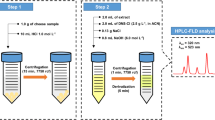Abstract
In the present study, a fast and sensitive method for the quantification of ochratoxin A in two lipidicproteic food matrices has been developed. In particular, the sample preparation procedure has been optimized for dry-cured meat products and blue cheeses and tested for several validation parameters (LOD, LOQ, recovery, repeatability and within-laboratory precision). The procedure has been then applied to several dry-cured meat products and blue cheeses from the market.
Ochratoxin A has been occasionally found in dry-cured and smoked ham from the market and the contamination occurred both in the outer and in the inner part of the products. Concerning the blue cheese, the occurrence of ochratoxin A is reported for the first time: OTA was occasionally found at low levels (0.1–3 μg/kg) in commercial samples of Roquefort from France and Gorgonzola from Italy, opening a new issue for risk assessment and quality control.
Similar content being viewed by others
References
Rodríguez M, Núñez F, Córdoba JJ, Sanabria C, Bermúdez E, Asensio MA (1994) Characterization of Staphylococcus spp. and Micrococcus spp. isolated from Iberian ham throughout the ripening process. Int J Food Microbiol 24: 329–335
Rodriguez M, Nunez F, Cordoba JJ, Bermudez E, Asensio MA (1996) Gram-positive, catalasepositive cocci from dry cured Iberian ham and their enterotoxigenic potential. Appl Environ Microbiol 62 (6): 1897–1902
Comi G, Orlic S, Redzepovic S, Urso R, Iacumin L (2004) Moulds isolated from Istrian dried ham at the pre-ripening and ripening level. Int J Food Microbiol 96: 29–34
Karlovsky P (1999) Biological detoxification of fungal toxins and its use in plant breeding, feed and food protection. Nat Tox 7: 1–23
Galtier P, Alvinerie M, Charpenteau JL (1981) The pharmacokinetic profiles of ochratoxin A in pigs, rabbits and chickens. Food Cosm Toxicol 19: 735–738
Ministero delia Sanità (1999) Circolare 09.06.1999. Gazzetta Ufficiale Repubblica Italiana, No. 135, 11.06.1999
Opinion of the Scientific Panel on Contaminants in the Food Chain on a request from the Commission related to ochratoxin A (OTA) in food. Request No EFSA-Q-2005-154 (2006) The EFSA Journal 365: 1–56
Gareis M (1996) Fate of ochratoxin A on processing of meat products. Food Add Contam 13 (Suppl.): 35–37
Gareis M, Scheuer R (2000) Ochratoxin A in meat and meat products. Arch Lebensmittelhyg 4/5: 102–104
Jorgensen K (2005) Occurrence of Ochratoxin A in commodities and processed food — A review of EU occurrence data. Food Add Contam S1: 26–30
Ockerman HW, Cespedes Sanchez FJ, Ortega-Mariscal MA, Leon Crespo F (2001) The lipolytic activity of some indigenous Spanish molds isolated from meat products. J Muscle Foods 12: 275–284
Rundberget T, Wilkins AL (2002) Determination of Penicillium mycotoxins in foods and feeds using liquid chromatography-mass spectrometry. J Chromatogr A 964: 189–197
Dall’Asta C, Galaverna G, Dossena A, Marchelli R (2004) Reverse-phase liquid chromatographic method for the determination of ochratoxin A in wine. J Chromatogr A 1024: 275–279
Battilani P, Pietri V A, Giorni P, Formenti S, Bertuzzi T, Toscani T, Virgili R, Kozakiewicz Z (2007) Penicillium populations in dry-cured ham manufacturing plants. J Food Prot 70: 975–980
Author information
Authors and Affiliations
Corresponding author
Additional information
Financial support: This work was partially granted by Emilia-Romagna region (projects: SIQUAL and “Safety and quality of typical pork meat production chain”)
Rights and permissions
About this article
Cite this article
Dall’Asta, C., Galaverna, G., De Dea Lindner, J. et al. A new validated HPLC-FLD method for detecting ochratoxin A in dry-cured meat and in blue cheese. Mycotox Res 23, 132–137 (2007). https://doi.org/10.1007/BF02951509
Received:
Accepted:
Issue Date:
DOI: https://doi.org/10.1007/BF02951509




